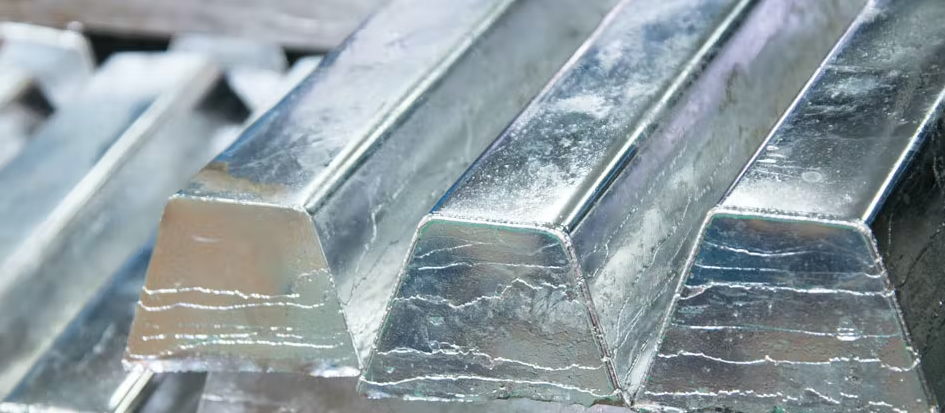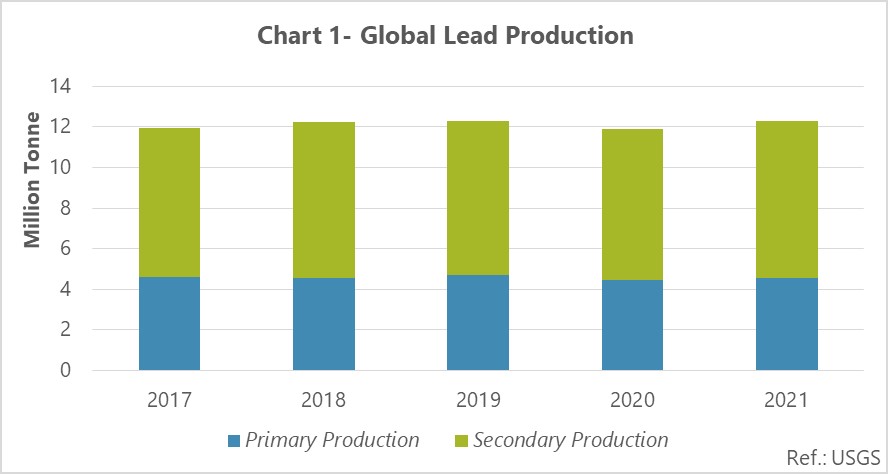Global lead production will increase by around 2% y/y in 2021, which is the result of production growth in China and India. Global production of mineral lead is estimated to increase by 2.9% to 4.71Mt in 2022, with the participation of China, India, and Kazakhstan.
China, Australia, and the US accounted for the highest volume of lead mineral production in 2021, with about 2Mt, 500kt, and 300kt, respectively. Global lead production is increasing with higher demand for lead-acid batteries from the automotive and electric bicycle sectors, especially from China and the US.
Lead is a toxic and formable element that has a dull gray color. Galena is a natural mineral of lead sulfide and the main mineral of lead metal in the mines of this metal. Lead and zinc are mainly exist together in the host ore, and its ore may also contain silver, copper, and gold. On this basis most mineral silver in the world is produced as a byproduct of lead and zinc mines. The ore must first be separated from the clay and other silicates, and then the lead ore is separated from the zinc ore. Pyro metallurgy method is mostly used to produce lead.
After separation, desulfurization and melting inside the rotating furnace, the obtained molten lead is transferred to the purification chambers to remove impurities and finally it is cast in the form of ingots. Lead ingots are produced in different degrees of purity, with degree of 99.95% to 99.99% is one of the best-selling type. Small volume of impurity in lead ingots mainly include antimony and silver, and lower amounts of other metals, including gold.
In chart 1, the amount of mining and recycling of lead from 2017 to 2021 has been analyzed. The mineral production of lead with 4.566Mt has grown by about 2% y/y in 2021. The average production of lead mineral was about 4.577Mt over the timeframe, with the CAGR of 1.49% of lead mineral production over the period. Mining and recycling zinc production has decreased in 2020 due to the Covid-19 outbreak. Unlike many minerals, recycled production accounts for a larger share of the global total lead supply than mineral production, according to the Figure 1.
Lead mineral production decreased by 5.2% to 4.4Mt in 2020. The outbreak of Covid-19 in late December 2019 significantly affected mining activities in the H1 2020, and recycled lead production also decreased from 7.599Mt in 2019 to 7.428Mt in 2020, down by 2%. Moreover, global lead production in q1 2020 declined by about 3.4% y/y. The production drop in China, India, and Kazakhstan due to the pandemic restrictions have had the greatest impact on the output in 2020.
Refined lead metal production is expected to grow by 1.3% to 12.44mt in 2022, which will be influenced by higher production in China, India, Kazakhstan, and Mexico. European production is expected to decline due to production cuts in Bulgaria, Germany, Italy, and Poland. The global supply of refined lead metal exceeded demand by 20kt during the first four months of 2022, according to the ILZSG.
The top seven mineral lead producers in the world
China is largest lead producer in the world by far. The other6 countries also mined significant amounts in 2021, according to the US Geological Survey. The shares of top seven lead producers is indicated in chart 2 from 2017 to 2021, in which China, Australia, the US, Peru, Mexico, Russia, and India had a share of 44%, 10%, 7%,6%, 6%, 5%, and 4% respectively. China produced 2Mt of the product in 2021, slightly more than the 1.9Mt produced in 2020. This production growth has happened despite the excess of lead in warehouses. The country has a number of large lead mines, including Yin Shan, Funko, and Ying.
As mentioned, China has the largest lead mineral production in the world by a significant margin. After China, Australia has produced around 500kt of the mineral lead in 2021, which slightly increased y/y. The country’s mineral lead production has grown by 2% on average from 2017 to 2021 per year that has the largest lead reserves globally. Lead production in the US reached 300kt in 2021, which is a drop from 306kt in 2020. Moreover, the production of recycled lead experienced an annual decrease of around 4% in 2021, caused by the closure of several secondary lead plants.
Peru had experienced a growth in lead production in 2021. The country produced 280kt of lead in 2021, while its output volume was 242kt in 2020. Mexico’s lead production reached 270,000 tons in 2021, which was slightly more than the country’s 260,000 tons in 2020. Mexico’s lead production reached 270kt in 2021, which was slightly more than the country’s 260kt in 2020. Mexico extract most of its lead from the La Platosa mine, which has high-grade lead and zinc reserves.
Unlike the countries mentioned above, Russia’s lead production remained unchanged at 210kt from 2020 to 2021. The country’s largest lead mines are the Uchalinsk state mine, as well as the Ural Mining and Volkovskoye. It should be seen what effect the Ukraine conflict and especially the imposition of sanctions and export bans will have on the country’s lead industry in 2020. India’s production as the other major mineral lead producer was almost constant as well.
Mineral lead production is expected to grow at an average rate of 4.2% and reach 5.2Mt in 2024, according to the report of reputable international institutions outlook. Peru, Australia, and China will be the main contributors to this growth. The total output in these countries is expected to increase from 2.8Mt in 2021 to 3.3Mt in 2024.



